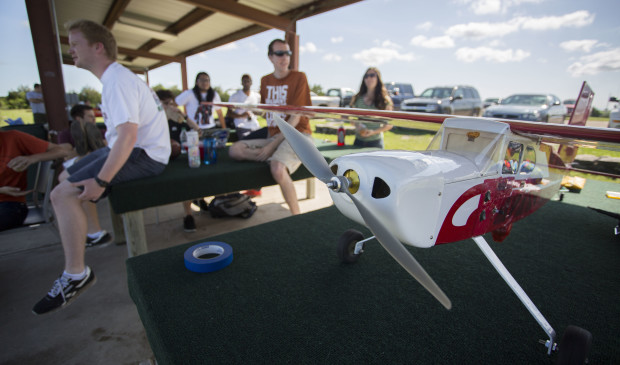Austin Fire Department could soon be using drones
Thursday, April 21, 2016 by
Audrey McGlinchy, KUT The drone idles on a small runway at the Austin Radio Control Association, just east of the city. It has a gray body and a white nose, across which someone has painted a sinister smile. The controls are tested, and then the small aircraft takes off.
“They’re going through with their first search,” says Sterling Maynard, a senior at the University of Texas at Austin. “So what they’re going to do is they’re going to basically do a lawnmower pattern and go around and cover this entire area with the camera.”
That camera sends live video back to computers hooked up inside a small trailer beside the runway. There, four students crowd four screens, assessing data being sent back to them from the small plane in the sky. Maynard is part of a 17-student team led by professor Armand Chaput. On this particular Wednesday afternoon, the team is demonstrating how drones can be used in a search-and-rescue mission following a natural disaster, such as a flood or tornado.
Pending approval from City Council members tomorrow, the Austin Fire Department will officially be teaming up with two state universities – the University of Texas and the University of North Texas – to consider how the department could employ drones to search for and rescue residents trapped during natural disasters.
Maynard points to the field beyond the runway. His team’s plane is circling it now.
“We have five targets out there,” he explains. “They’re represented by blue and silver tarps, and then the two targets of interest will have either a smiley face or a frowny face.”
The “targets of interest,” which are wooden circles on which a sad or happy face has been painted, are there to represent people in need of rescue – the sad face represents someone who needs immediate medical attention. The tarps, Maynard says, could be roofs – often safe havens after homes have been deluged by floodwaters.
In Denton, researchers at the University of North Texas have come up with a drone that carries with it a Wi-Fi signal.
“The idea is that after a disaster – whether it’s a tornado, an earthquake, a flood, what have you – there will be people who are trapped somehow, whether it’s in a car or in their home,” says Leslie Minton, a spokeswoman for the University of North Texas. “But likely they have a smartphone on them.”
However, as Minton explains, in many cases cell service is out. The Wi-Fi drones flown by UNT researchers can enable communication so that victims of a disaster can connect with emergency responders, or even with family members concerned about their safety. The signal could also be used by responders to communicate with one another.
There is no specific cost attached to these agreements, and knowledge is the only thing being exchanged – the city will not be paying the university, nor will the university be paying the city. Costs will include staff time plus educational materials and technical support. Per city policy, the Austin Fire Department does not discuss items before they have gone to Council.
As for Maynard, the UT senior says that the fire department’s interest demonstrates how practical this course has been.
“I know for a fact we have a mapping software that we’ve developed that they might be interested in,” he says. “So it’s kind of nice that there’s actually some benefit to what we’re doing and it’s not just a college class.”
This story was produced as part of the Austin Monitor’s reporting partnership with KUT.
Photo by Miguel Gutierrez Jr.
You're a community leader
And we’re honored you look to us for serious, in-depth news. You know a strong community needs local and dedicated watchdog reporting. We’re here for you and that won’t change. Now will you take the powerful next step and support our nonprofit news organization?










